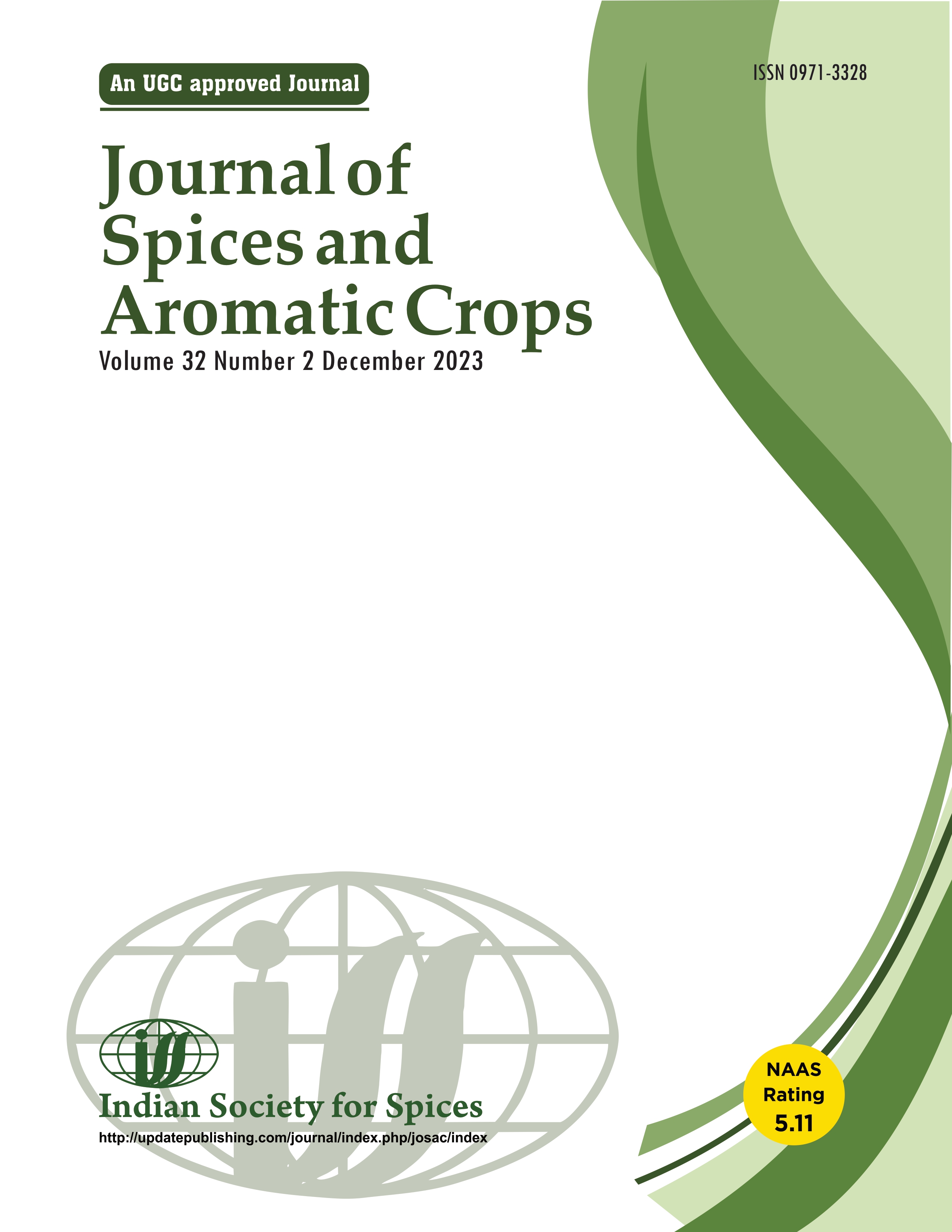Morphological and biochemical characterization of Alpinia calcarata rhizomes
characterization of Alpinia calcarata rhizomes
DOI:
https://doi.org/10.25081/josac.2023.v32.i2.8876Keywords:
Alpinia calcarata, biochemical characters, GC MSMS analysis, rhizome, variabilityAbstract
Lesser galangal rhizomes are well known for their anti-inflammatory, anti-microbial and anti-oxidant properties. The aim of the present study was to assess the variability in morphological and biochemical characters of lesser galangal, Alpinia calcarata accessions collected from various South Indian states. The results revealed that accession IC373608 was significantly superior with respect to yield contributing traits including the rhizome length, width, fresh yield and dry recovery (6.02 cm, 2.40 cm, 14.63 g tiller-1 and 33.26% respectively) among the eighteen accessions studied. The biochemical analysis of rhizomes revealed that the maximum volatile oil and oleoresin content were found in the accession IC468880 (0.75%) and IC373608 (34.20%) respectively. The highest values for total phenols, total flavonoids and starch were observed in the accessions IC373608 (115.25 mg GAE.g-1), IC582825 (55.65 mg QE. g-1) and IC210656 (44.05 mg. g-1) respectively. The accession IC550112 (7.90%) recorded the lowest crude fibre content, whereas the highest total terpenoid content was noticed in accession IC210421 (20.25%). The GCMSMS profiling of volatile oil of A. calcarata rhizome showed the presence of 28 compounds in it. Considering all economically important characters, accessions IC373608, IC582825 and IC210421 were found to be superior and can be utilized in future crop improvement programmes.
Downloads
References
Afra N A M & Ghannam H A E 2022 Utilization of rhizome (Alpinia galanga L.) in improvement of some quality attributes of some processed meat. Food Nutr. Sci. 13: 761–779.
Arambewela L S, Kumaratunge A, Arawwawela M, Owen N L & Du L 2005 Volatile oils of Alpinia calcarata Rosc. grown in Sri Lanka. J. Essent. Oil Res. 17: 124–125.
Arambewela L S R & Arawwawala L D A M 2010 Standardization of Alpinia calcarata Roscoe rhizomes. Pharmacognosy Res. 2: 285–288.
Bhuiyan M N I B, Begum J & Nandi N C 2011 Volatile constituents of essential oils isolated from different parts of Alpinia calcarata Rosc. Afr. J. Plant Sci. 5: 349–352.
Datta R, Saxena H O & Kakkar A 2018 Phytochemical evaluation and antibacterial activity of four Indian species. Asian J. Pharm. Pharmacol. 4: 806–809.
Ferguson N M A 1962 Text Book of Pharmacognosy. Mac Milan Company, New Delhi. pp.191.
Guenther E 1972 The Essential Oils, Vol. 4. Rober E Krieger Publishing Co. Inc., Huntington, New York, pp.150–180.
Hedge J E & Hofreiter B T 1962 In: Carbohydrate Chemistry, 17 (Eds. Whistler RL, Miller JN.), Academic Press, New York.
Indrayan A K, Agrawal P, Rathi A K, Shatru A, Agrawal N K & Tyagi D K 2009 Nutritive value of some indigenous plant rhizomes resembling ginger. Nat. Product Radiance. 8: 507–513.
Jayaweera D M A 1981 Medicinal Plants. Part III, National Science Council of Sri Lanka Publication, Colombo, pp.101.
Jisha M, Hukuman N Z, Leena P & Nair V 2021 Antioxidant, antimicrobial, anticorrosion and molecular docking studies in Alpinia calcarata Rosc., rhizome and leaf extracts. J. Mater. Environ. Sci. 12: 244–270.
KAU (Kerala Agricultural University) 2016 Package of Practices Recommendations: Crops (15th Ed.). Kerala Agricultural University, Thrissur, 393p.
Khandel P, Shahi S K, Soni D K, Yadaw R K & Kanwar L 2018 Alpinia calcarata: Potential source for the fabrication of bioactive silver nanoparticles. Nano convergence. 5: 1–17.
Mallik C P & Singh M B 1980 Plant enzymology and histoenzymology. A text manual. pp.59–60.
Mathew S, Britto S J & Thomas S 2014 Comparative powder microscopical screening of the rhizome and leaf of Alpinia calcarata and Alpinia galanga. Int. J. Pharm. Sci. Res. 5: 1449–1453.
Namdeo A G & Kale V M 2015 Comparative pharmacognostic and phytochemical investigation of two Alpinia species from Zingiberaceae Family. World J. Pharm. Res. 4: 1417–1432.
Nampoothiri S V, Menon A N, Esakkidurai T & Pitchumani K 2016 Essential oil composition of Alpinia calcarata and Alpinia galanga rhizomes-a comparative study. J. Essent. Oil Bearing Plants. 19: 82–87.
Nohir G D R, Mostafa U E & El-Hadidy E M 2019 Effect of galangal (Alpinia galanga) as hypoglycemic and hypolipidemic agents in diabetic Albino rats. Egypt. J. Nutrition. 3: 337–357.
Ponmozhi, T & Kalaiselvi K 2011 Morphological, histo-anatomical and biochemical studies in Alpinia spp. Biochem. Indian J. 5: 109–114.
Raina A P & Abraham Z 2015 Chemical composition of essential oils obtained from plant parts of Alpinia calcarata Rosc. (lesser galangal) germplasm from South India. J. Essent. Oil Res. 27: 238–243.
Raj N, Nadeem S, Jain S, Raj C & Nandi C K 2011 Ameliorative effects of Alpinia calcarata in alloxan-induced diabetic rats. Dig. J. Nanomater. Biostructures. 6: 991–997.
Ramya R, Kalaiselvi M, Narmadha R, Gomathi D, Bhuvaneshwari V & Amsaveni R 2015 Secondary metabolite credentials and in vitro free radical scavenging activity of Alpinia calcarata. J. Acute Med. 5: 33–37.
Sadasivam S & Manickam A 1992 Biochemical Methods for Agricultural Sciences. Wiley eastern limited, 270p.
Sereena K, Kumar U P & Shree A B R 2011 Histochemical and phytochemical marker for the authentication of ayurvedic raw drug hallakam (Kaempferia rotunda) and its marketed adulterant. Int. J Pharm. Sci. Res. 2: 2952–2958.
Singh S, Sahoo B C, Kar S K, Sahoo A, Nayak S & Kar B 2020 Chemical constituents analysis of Alpinia galanga and Alpinia calcarata. Res. J. Pharm. Technol. 13: 4735–4739.
Singh T S, Phucho T & Singh T B 2015 Phytochemical evaluation, determination of total terpenoid content in the rhizome of Curcuma amada. World J. Pharm. Res. 4: 2286–2294.
Tewari A, Pant A K, Mathela C S, Mengi N, Kohl E & Bestmann H J 1999 Volatile Constituents of Alpinia calcarata Rosc. J. Essent. Oil Res. 11: 739–741.
Trimanto T, Hapsari L & Dwiyanti D 2021 Alpinia galanga (L.) Willd: Plant morphological characteristics, histochemical analysis and review on pharmacological properties. In AIP Conference Proceedings (AIP Publishing LLC). 2353: pp.030021.
Published
How to Cite
Issue
Section
Copyright (c) 2023 K Shibila, A K Aneesha, A Suma, P Anitha, C R Rashmi

This work is licensed under a Creative Commons Attribution-NonCommercial-NoDerivatives 4.0 International License.






 .
.